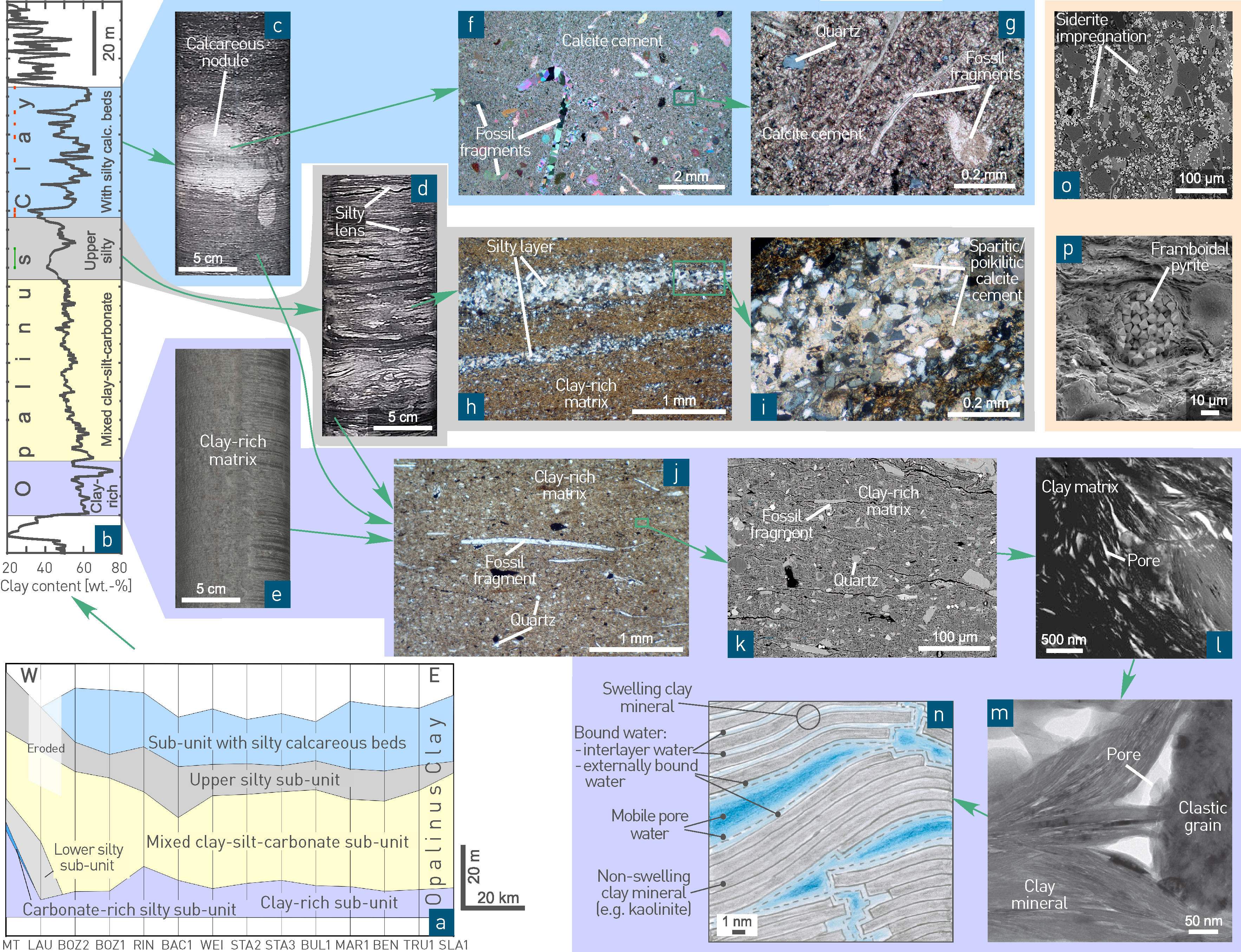The sedimentological and stratigraphic features of the Opalinus Clay are presented in Section 4.2.6.
The structure of the Opalinus Clay on scales between tens of km to 1 nm, i.e. a scale ranging over 13 orders of magnitude, is illustrated in Fig. 5‑2. The main methods and sources of information include, in order of decreasing scale, geophysical borehole logs, macroscopic core inspection, thin-section analysis, scanning electron microscopy (SEM) and transmission electron microscopy (TEM). More detail is provided in Mazurek & Aschwanden (2020).
On a regional scale, several Opalinus Clay subunits can be distinguished and correlated laterally (Section 4.2.6). The same subunits can be identified in all three siting regions, and only a minor variability of the total thickness of the Opalinus Clay can be seen.

Fig. 5‑2:Conceptual representation of the structure of the Opalinus Clay over a length scale range of 13 orders of magnitude
Adapted from Mazurek & Aschwanden (2020). MT: Mont Terri.
(a) Regional distribution of subunits
(b) Typical borehole profile with subunits, discrete heterogeneities and clay-mineral log (Benken borehole, BEN)
(c) Calcareous nodule in the «Sub-unit with silty calcareous beds» (BEN 549.22)
(d) «Upper silty sub-unit» (BEN 582.83)
(e) «Clay-rich sub-unit» (Mont Terri rock laboratory, MT BDB-1 220.74)
(f) Thin-section photograph of a calcareous nodule from the «Sub-unit with silty calcareous beds» (Schlattingen borehole, SLA 852.80, transmitted light, crossed polars)
(g) Detail from (f)
(h) Thin-section photograph from the «Upper silty sub-unit» showing two silty lenses (BEN 575.35, transmitted light, parallel polars)
(i) Thin-section photograph from the «Upper silty sub-unit» showing a close-up of a silty lens cemented by sparitic/poikiloblastic calcite (MT 808.40, transmitted light, crossed polars)
(j) Thin-section photograph from the «Clay-rich sub-unit» (MT 968.50, transmitted light, parallel polars)
(k) SEM image from the «Clay-rich sub-unit» (MT FE tunnel, from Seiphoori et al. 2017)
(l) TEM image of the clay matrix (from Keller & Holzer 2013)
(m) TEM image of the clay matrix (MT sample, from Keller et al. (2013)
(n) Artist’s view of the clay structure on the nanometre scale (from Nagra 2002)
(o) Siderite impregnation in a concretion (SLA 833.69, from Wersin et al. 2013)
(p) Pyrite framboid (MT FE tunnel, from Seiphoori et al. 2017).
On the borehole scale (Fig. 5‑2b), discrete heterogeneities such as calcareous beds/nodules with a thickness in the range of 0.1 – 0.6 m (Mazurek & Aschwanden 2020) occur in the upper part of the formation in all the siting regions. It should be noted that, even in sections with calcareous beds/nodules present, the average clay-mineral content at the metre scale is > 40 wt.-%. Individual heterogeneities often cannot be correlated between boreholes, indicating limited lateral extent. At the base of the Opalinus Clay, a particularly clay-rich layer extends across the whole study area, with average clay-mineral contents well above 50 wt.-%.
On this basis, the Opalinus Clay illustrated in Fig. 5‑2c – e can be conceptually simplified to:
-
Clay matrix with variable contents of disseminated quartz and calcitic fossil fragments in all subunits
-
Calcareous beds/nodules
-
Silty lenses, most frequently occurring in the silty subunits.
The small-scale calcareous and silty heterogeneities are embedded in a clay-rich matrix, which is the dominant building block. This fact is illustrated by arrows pointing from Fig. 5‑2c – e towards Fig. 5‑2j. Calcareous beds/nodules are illustrated in Fig. 5‑2f – g on the thin-section scale. They consist of fossil fragments, silty particles and a calcite cement, with only small amounts of clay minerals. Fig. 5‑2h – i illustrate silty lenses on a microscopic scale. These can contain clay minerals or, as shown in Fig. 5‑2h – i, consist of almost pure quartz ± feldspars. Given the originally large pore apertures, the lenses are mostly cemented by sparitic and/or poikilitic calcite cement.
The clay-rich matrix is the quantitatively dominant building block of the Opalinus Clay and is illustrated in Fig. 5‑2j – n. It contains varying amounts of disseminated quartz and calcitic fossil fragments (Fig. 5‑2j – k). Note that, under the SEM, only a small fraction of the pore space can be visualised, given the limited resolution (at best around 10 nm). Fig. 5‑2l – m visualises the clay matrix under TEM. Visible pores are due to geometric incompatibilities between clay aggregates or between clay and non-clay minerals. Pores with even smaller, nanometric apertures constitute a substantial part of the pore space. These apertures are difficult or impossible to image and are thus illustrated by a conceptual sketch in Fig. 5‑2n. Porosity is also present in the interlayer space of swelling minerals, particularly smectite (within illite/smectite mixed-layer minerals).
Apart from the cementation by several calcite generations, siderite and pyrite are the only quantitatively relevant diagenetic neoformations (Section 5.2.5) and occur in all subunits of the Opalinus Clay (Fig. 5‑2o – p). Siderite can be found in concretions with sizes in the range of centimetres or as disseminated crystals in the clay matrix. Pyrite occurs in the form of 1 – 10 µm-size framboids or as larger crystals. Pyrite concretions are also found, even though much less frequently than in the case of siderite.

